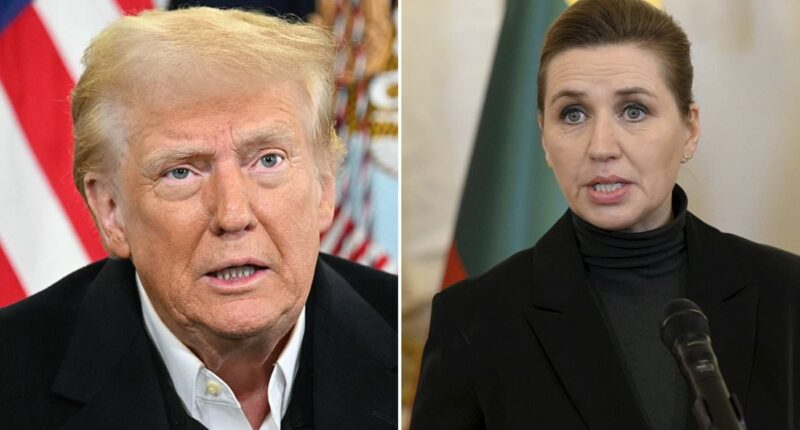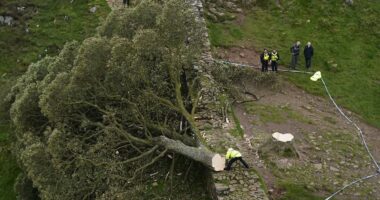Donald Trump unleashed a torrent of aggression in a ‘horrendous’ 45-minute phone call with Denmark’s Prime Minister as the pair discussed the fate of Greenland.
The confrontation has been described by senior officials as ‘explosive’ and centered on the President’s insistence the country was critical for national security.
The call, which took place on January 15, five days before he became Commander-in-Chief spiraled into an unprecedented diplomatic clash.
Trump, 78, reportedly threatened to impose tariffs on Denmark, a NATO ally, as a way of pressuring Mette Frederiksen, 47, to acquiesce to his territorial ambitions.
According to sources as revealed to the Financial Times, the conversation raised concerns that Trump is actually serious about possible military action.
‘It was horrendous. He was very firm. It was a cold shower. Before, it was hard to take it seriously. But I do think it is serious, and potentially very dangerous,’ the source said.
The call showcased Trump’s determination to push American interests in the Arctic, a region he views as a critical battleground for global power competition with China and Russia.
‘We are open for business, but we’re not for sale,’ Greenland’s foreign minister Ane Lone Bagger told Reuters.

Then President-elect Donald Trump unleashed a torrent of aggression in a ‘horrendous’ fiery 45-minute phone call with Denmark’s Prime Minister, Mette Frederiksen, as the pair discussed the fate of Greenland

During the call, Frederiksen was unyielding and reportedly cited Greenland’s Parliament, which had unequivocally declared that the island was ‘not for sale’

Trump’s fixation on Greenland is emblematic of his broader vision of American expansionism. Pictured, the capital of Greenland, Nuuk
Greenland’s strategic location along the shortest route from Europe to North America, vital for the U.S. ballistic missile warning system, has made it a priority for Trump.
While National Security Council spokesperson Brian Hughes declined to comment on the tone of the call, he issued a carefully worded statement reiterating Trump’s focus on Greenland.
‘President Trump has been clear that the safety and security of Greenland is important to the United States as China and Russia make significant investments throughout the Arctic region,’ Hughes said.
He added that Trump was committed to ‘working with Greenland to ensure mutual prosperity.’
Greenland’s Prime Minister Mute Egede, who has stepped up a push for independence, echos sentiments from Frederiksen and the foreign minister, saying the island is not for sale and that it is up to its people to decide their future.
While Trump also aired the possibility of taking over Greenland in 2019, his refusal to rule out the use of military or economic power has caught many Danes by surprise.
Trump’s fixation on Greenland is emblematic of his broader vision of American expansionism.
During his inauguration speech, he framed the U.S. as a ‘growing nation’ with ambitions to expand its territory.

The US seeks a greater share in emerging trade routes with its Greenland initiative, while Russia’s Northern Sea Route and China’s Polar Silk Road have drawn significant attention in recent years

A view of Greenland’s capital, Nuuk
His grandiose vision even extended to musings about annexing Canada and retaking the Panama Canal. But Greenland appears to hold a special allure for the president, who views it as both a strategic military asset and an economic opportunity.
Frederiksen, however, was unyielding. During the call, she reportedly cited Greenland’s Parliament, which had unequivocally declared that the island was ‘not for sale.’
She also emphasized Denmark’s commitment to Arctic security, proposed bolstering trade relations with the U.S., and reminded Trump of the EU’s shared interests with America in strengthened economic ties.
But her pragmatic approach seemed to have little effect on Trump, who had publicly hinted at using economic or even military force to assert U.S. control over Greenland.
At least five current and former senior European officials told the FT that Trump’s response was ‘aggressive’.
Frederiksen, described by foreign policy experts as a no-nonsense leader with a tough, security-focused approach, is not one to back down easily.
A U.S. foreign policy insider who had met with Frederiksen described her as ‘the John Bolton of Europe,’ a comparison to Trump’s former national security adviser, known for his hawkish stance.

Greenland has been politically linked with Europe – in particular Norway and Denmark – since the 9th Century. It has been inhabited by the Inuit people for around 800 years

Greenland was colonised in 1721 with the permission of the Kingdom of Denmark-Norway and remained a colony of Denmark until 1979. It is now an autonomous territory of Denmark

At 836,000 square miles, Greenland is a scarcely populated, arctic autonomous territory of Denmark. When comparing it to the purchase of Alaska from Russia in 1867, it can be estimated that Greenland’s total price would come out to approximately $230.25 million – though it’s not likely the same metrics would be use to determine worth
Frederiksen’s unwillingness to entertain Trump’s demands may have exacerbated the tension, leading to what insiders described as a verbal standoff.
‘She doesn’t seem like the type that would give any ground,’ an expert said to The Hill. ‘Not that she’s unreasonable, but she’s not the kind that would take any s***.’
The Prime Minister’s firmness reportedly left Trump fuming, with speculation swirling that her tough line provoked the escalation.
Hours after being sworn into office on Monday, Trump doubled down on his determination to bring Greenland under U.S. control.
Speaking from the Oval Office, he dismissed Denmark’s objections with characteristic bravado. ‘I’m sure that Denmark will come along,’ Trump said, shrugging off the diplomatic rift.
While geographically it is part of the continent of North America, Greenland has been politically linked with Europe – in particular Norway and Denmark – since the 9th Century. It has been inhabited by the Inuit people for around 800 years.
It was colonised in 1721 with the permission of the Kingdom of Denmark-Norway and remained a colony of Denmark until 1979. It is now an autonomous territory of Denmark.
The Danish government has control of Greenland’s foreign and economic policy, but the territory left the EU in 1985 following a referendum.
The US has a military base there given its strategic position as the shortest oceanic crossroads between North America and Europe.
The island also has a large supply of valuable rare earth minerals – like uranium – not found in the US.

















